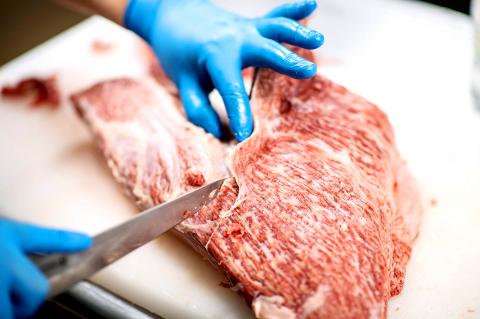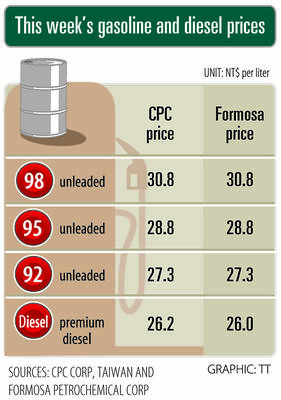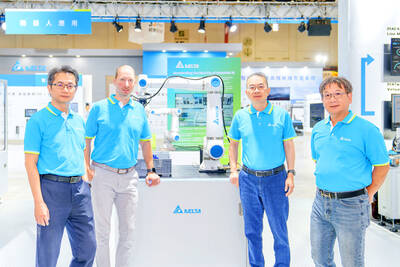In a lush field in the heart of the Japanese mountains, a herd of glossy black cows roamed happily — prime examples of the area’s Hida brand of wagyu beef. With consumption of the famed meat known for its melt-in-the-mouth tenderness and marbled fat on the decline in Japan, producers have been looking overseas to boost sales instead.
The Hida brand might not yet have the recognition of famed Kobe beef, but overall the international profile of wagyu is on the rise. The value of exports has risen more than 200 percent in the past five years — Hong Kong is the largest market.
About an hour from Takayama, a town that attracts tourists with its traditional wooden houses, dozens of cows owned by different farmers have free range across a 250 hectare plot leased by the local municipality.

Photo: AFP
They spend the warm summer months in the tranquil greenery and return to the warmth of the stables when the winter comes around.
There they give birth to calves that are the product of carefully organized breeding to protect the “purity” of each cow’s bloodline.
“It’s important to preserve the bloodline, because good genes guarantee good quality meat,” said Koichi Maruyama, a local official in charge of the cattle rearing department.
“The quality also comes from the feed,” he added.
For cows bred for wagyu beef, that means 10kg of rice straw per day to ensure the intramuscular marbling that gives the meat its characteristic look and taste.
Each cow spends the 30 months of its life cosseted and pampered, reared stress-free and under constant medical watch.
They are tagged electronically, in a system described as unique in the world, and every cow’s family tree can be traced back at least to its grandparents, if not further.
Some farmers pamper their cows by covering them in coats during the winter, feeding them beer and even playing them classical music.
Producers in Takayama do not go that far, but that does not mean there is much room for error.
“We never rest, we’re looking after them 24 hours a day, 365 days a year,” Shuichi Mizobata said on the sidelines of a locally organized wagyu competition.
Cows parade in front of judges and are weighed and measured to determine which is to compete at a national face-off that takes place every five years.
A Takayama cow won in 2002, a victory that still sparks pride for the young Hida brand.
Wagyu cultivation dates back only a few decades, with most Japanese black cattle — the breed that dominates wagyu — derived from a single bull born 80 years ago.
“After the liberalization of beef import rules, we decided to put the focus on very high quality wagyu beef to differentiate our products from imported ones,” Japanese Ministry of Agriculture, Forestry and Fisheries official Sota Kamihiro said.
Producers have also struggled with a decline in beef consumption that started in about 2000, over fears linked to bovine spongiform encephalopathy, commonly known as mad cow disease, and a shrinking number of farmers, with existing producers aging and leaving behind no heirs.
In 2013, the ministry set new export targets with the goal of reaching ¥25 billion (US$228.3 million) in beef sales overseas by this year.
The goal looks achievable, with sales last year totaling ¥24.7 billion, a massive increase from ¥5 billion when the strategy was put in place.
The explosion in exports has come despite the eye-watering cost of the product — the most prized portions of wagyu go for about ¥13,700 per kilo.
In Takayama, exports only accounted for 5 percent, or 43 tonnes, of the beef sold by producers in 2017, but that was already double the previous year.
The town has an abattoir that observes stringent rules and is one of just four in Japan certified to handle meat for export to the EU.
Increasingly, producers are also securing halal certification for slaughterhouses — which number about 200 in Japan — so they can export to Muslim countries.
After slaughter, the beef is put up for auction, with the carcasses displayed behind glass alongside cards ranking them according to a precise system based on the meat’s marbling, color, texture and the quality of the fat, abattoir director Mitsushi Kobayashi said.
“The Japanese seek above all to reduce the blood and muscle in the animal, and to develop the fat, the opposite of us,” said French chef Lionel Beccat, who has a Michelin-starred restaurant in Tokyo.
“The meat is sublime, it melts in the mouth, there are different notes depending on the cows — some are floral, others nutty, others spicy,” he said. “So the meat can be appreciated as it is, you just grill it and that’s it. It’s very Japanese, like sashimi.”

SETBACK: Apple’s India iPhone push has been disrupted after Foxconn recalled hundreds of Chinese engineers, amid Beijing’s attempts to curb tech transfers Apple Inc assembly partner Hon Hai Precision Industry Co (鴻海精密), also known internationally as Foxconn Technology Group (富士康科技集團), has recalled about 300 Chinese engineers from a factory in India, the latest setback for the iPhone maker’s push to rapidly expand in the country. The extraction of Chinese workers from the factory of Yuzhan Technology (India) Private Ltd, a Hon Hai component unit, in southern Tamil Nadu state, is the second such move in a few months. The company has started flying in Taiwanese engineers to replace staff leaving, people familiar with the matter said, asking not to be named, as the

The prices of gasoline and diesel at domestic fuel stations are to rise NT$0.1 and NT$0.4 per liter this week respectively, after international crude oil prices rose last week, CPC Corp, Taiwan (台灣中油) and Formosa Petrochemical Corp (台塑石化) announced yesterday. Effective today, gasoline prices at CPC and Formosa stations are to rise to NT$27.3, NT$28.8 and NT$30.8 per liter for 92, 95 and 98-octane unleaded gasoline respectively, the companies said in separate statements. The price of premium diesel is to rise to NT$26.2 per liter at CPC stations and NT$26 at Formosa pumps, they said. The announcements came after international crude oil prices

STABLE DEMAND: Delta supplies US clients in the aerospace, defense and machinery segments, and expects second-half sales to be similar to the first half Delta Electronics Inc (台達電) expects its US automation business to remain steady in the second half, with no signs of weakening client demand. With demand from US clients remaining solid, its performance in the second half is expected to be similar to that of the first half, Andy Liu (劉佳容), general manager of the company’s industrial automation business group, said on the sidelines of the Taiwan Automation Intelligence and Robot Show in Taipei on Wednesday. The company earlier reported that revenue from its automation business grew 7 percent year-on-year to NT$27.22 billion (US$889.98 million) in the first half, accounting for 11 percent

A German company is putting used electric vehicle batteries to new use by stacking them into fridge-size units that homes and businesses can use to store their excess solar and wind energy. This week, the company Voltfang — which means “catching volts” — opened its first industrial site in Aachen, Germany, near the Belgian and Dutch borders. With about 100 staff, Voltfang says it is the biggest facility of its kind in Europe in the budding sector of refurbishing lithium-ion batteries. Its CEO David Oudsandji hopes it would help Europe’s biggest economy ween itself off fossil fuels and increasingly rely on climate-friendly renewables. While